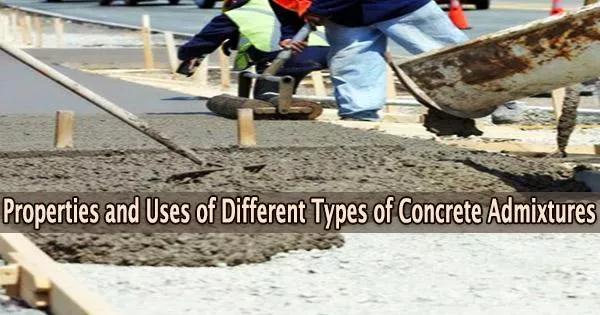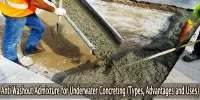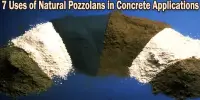What are Concrete Admixtures?
Concrete admixtures are substances other than cement, water, and aggregates that give plastic (fresh) mix or hardened concrete (ASTM C496) a particular property.
Why use Concrete Admixtures?
- Reduce the cost of concrete construction
- Achieve specific concrete properties more effectively
- Maintain concrete quality when mixing, transporting, putting, and curing it in inclement weather
- Overcome emergencies during operations
Classification of Concrete Admixtures:
- Air entrainers
- Water reducers
- High-range water reducers-superplasticizers
- Retarders
- Accelerators
- Fine minerals
- Specialty admixtures
Air entraining concrete admixture:
To create space for the water to expand when it freezes, air entraining concrete admixtures create minute air bubbles in the hardened concrete.
How do they work?
They are anionic (water-hating) agents that form tough, elastic, air-filled bubbles. These bubbles reduce stresses caused by movement or freezing of water. They provide more volume for expansion and shorter flow path.
Benefits of air-entraining admixture:
- Increases workability of fresh concrete
- Increased durability; Better resistance to freezing thaw cycles, de-icers, salts, sulfates, and alkali-silica reactivity
Difficulties:
- Decreases strength
- The effect can be reduced in moderate strength concrete by lowering water cement ratio and increasing cement factor
Composition of Air Entrainers:
- Salt of wood resins (Vinsol resin)
- Synthetic detergents
- Salts of sulfonated lignin (by-product of paper production)
- Salts of petroleum acids
- Salts of proteinaceous material
- Fatty and resinous acids
- Alkylbenzene sulfonates
- Salts of sulfonated hydrocarbons
Usually liquid meets ASTM C260 specifications.
Water Reducing concrete admixture:
Water reducers can result in 3 things:
- Increased slump at constant w/c
- Increased strength, by lowering the water content
- Reduced cost of the cement
How do they do this? Water reducers make the cement particles in the plastic mix more mobile, which makes it possible to obtain the same workability at lower water contents.
Superplasticizers
Superplasticizers are “high-range” water reducers. Superplasticizers are used when placing:
- Thin sections or around tightly spaced reinforcing steel
- concrete underwater
- Concrete by pumping
- consolidating the concrete is difficult
Note: Superplasticizers are typically added on site because they only keep fresh concrete workable for a short time (30 to 60 minutes) when they are utilized
Retarding concrete admixture:
Used to delay the initial set of concrete. Why do we use them?
- To offset the effect of hot weather
- Allow for unusual placement or long haul distances
- Provide time for special finishes
Possible adverse effects of retarders 1. Reduce early age strength 2. Reduction of time between initial and final set Possible advantages of retarders
- Air entrainment
- Increased workability
- Reduction of time between initial and final set
Note: The use of retarders must be evaluated experimentally before incorporation in mix design
Accelerating concrete admixture:
Used to reduce the time required to develop final strength characteristics in concrete Possible reasons for using accelerators:
- Reduce the amount of time before finishing operations begin
- Reduce curing time
- Increase rate of strength gain
- Plug leaks under hydraulic pressure efficiently
- Offset effect of cold weather
The PCA (Portland Cement Association) recommends against using calcium chloride when:
- Concrete is prestressed
- Concrete contains embedded aluminum such as conduits
- Concrete is subjected to alkali-aggregate reaction
- Concrete is in contact with water or soils containing sulfates
- Concrete is placed during hot weather
- Mass application of concrete
Alternatives to CaCl2
- High early strength cement (type III)
- Increase cement content
- cure at higher temperature (if feasible)
- Triethanolamine, sodium thiocyanate, calcium formate, calcium nitrite or calcium nitrate
Fine Minerals as concrete admixtures:
Large amounts (20% to 100% of cement weight) of fine mineral admixtures are added to concrete to enhance the properties of flexible and hardened concrete. Classification based on chemical and physical properties
Cementitious
Have hydraulic cementing properties Example: blast furnace slag, natural cement and hydraulic hydrated lime
Pozzolanic
- Siliceous and aluminous material
- Little or no cementitious value
- When moisture is present, calcium hydroxide will react to create compounds having cementitious characteristics. Hydrated lime makes up 15% of PC weight. Addition of pozzolan could make the hydrated lime into a cementitious material
Classification of fly ash and natural pozzolans
- Class N: Raw or calcined natural pozzolans, e.g. diatomaceous earth, opaline cherts and shales, ruffs and volcanic ashes, & some calcined clays and shales
- Class F: Fly ash with pozzolan properties
- Class C: Fly ash with pozzolan and cementitious properties
Fly ash is the most commonly used pozzolan in civil engineering structures
Special concrete admixtures:
Other admixtures, such as workability agents, bonding agents, etc., are available to enhance concrete quality in various ways.
















